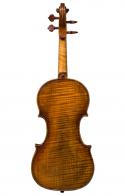Violin Testore Model

Testore model violin made by Pablo Alfaro
My "Bob Wallace" Violin
“I'm not going to get that prize ever” I thought many years ago. For the last eight years, I was just another attendee on the sidelines of a parade - sometimes surprised but always happy for the winner. The “Bob Wallace” started to be more than an illusion, I should say, it had become an obsession.
How to win “the” award? One just needed to make the right violin, that simple! However, it's easier said than done. I have been making experiment after experiment for some years now; personal models, copies from posters and calendars, always trying different patterns and building techniques. I showed my instruments to makers everywhere: conventions, competitions, courses, friends, etc. The great advice I was given in the past was, “Copy from the original.”
The model:
I have been very lucky. Many of my customers have great instruments. To be so close to fine instruments is certainly inspiring. I just needed to pick the one to make a copy after. After serious contemplation, I decided on a beautiful violin made by Petrus Guarnerius of Mantua from 1714, the “ex Caressa”, which is mentioned in Hill's book as one of the best examples of that great Master. Since I had the Guarnerius violin week after week for tone adjustments (Have you ever had one of those customers?), I decided I would have enough access to the instrument to make a copy. I took over two hundred pictures along with the exact measurements of the violin, and I was ready to begin a new adventure...to make a clone from this piece of art.
Choosing the wood:
I own over sixty sets of wood (good wood). To find a similar match to the original one was a challenge. In the end, I used two pieces of European medium-grained maple from 1974 (that I had purchased from an old French violinmaker in Orem, Utah in 2000) for the back of the violin, while the ribs and scroll were made from an American maple wood from 1974 (which was purchased from my friend, Carlos Funes in 2002). The two-piece top was made of spruce from 1984 (purchased from another friend in 2005). For the linings and corner blocks, I used balsa-wood, while the top and bottom blocks were also made of spruce.
The nightmare:
In deciding the building technique I would need to perform, there were two alternatives: a mold (in which case, I would need to make one) or being more adventurous and playing it by ear. Any decision would be a difficult decision. Hence, I opted for the second option - to build a l'air - and hope for the best. I found a Del Gesu model (the 1740 Ysaye) which was almost identical to the outline of the original violin, so I decided to use that pattern. I started by making the back and the top. The next step was to make the ribs and glue them together. Unfortunately, the top didn't match the back. Therefore, the solution was to twist the ribs. This technique involves building blocks from the back of the violin first in order to match the top. Then, I continue by bending the ribs to try and match the blocks as well as the top of the violin. Push here! Pull there! Hold here! Push more! Careful! HELP!!! Experience comes at a high cost! The hours I used to work have taught me all of this and more.
Once I glued the body together, all that was left was to varnish the violin and carve the scroll. I copied every detail of the original model by antiquing the new violin as closely to it as humanly possible: tool marks, scratches, crackled varnish, etc. In the end, I had finally made a beautiful instrument.
The magic moment:
The moment one tunes a newly built violin is always an emotional one. The two questions which came to mind were, “Is the neck going to hold?” and “How is it going to sound?” My hands were sweating and shaking, and I was ready to play my own violin for the very first time. What should I play? After all, this is the “magic moment” I've been waiting for. It is like the first cry of a newborn baby. Hence, I decided to play a song called Days of Wine and Roses - an old, cheesy melody which one would find playing in a bar. I was very pleased. After all, my effort and time spent on this project was not a lost cause. I had achieved my childhood dream - to make a violin come to life.
Epilogue: When I was 14, I had my first encounter with violinmaking. My uncle asked me to go with him to visit a “Luthier” in Amsterdam. Fred Lindemann invited us to tour his shop. I was so impressed that I went home and built my fist violin out of a cardboard box. Today, I am proud to be an addition to the list of winners of the “Bob Wallace” Prize.
